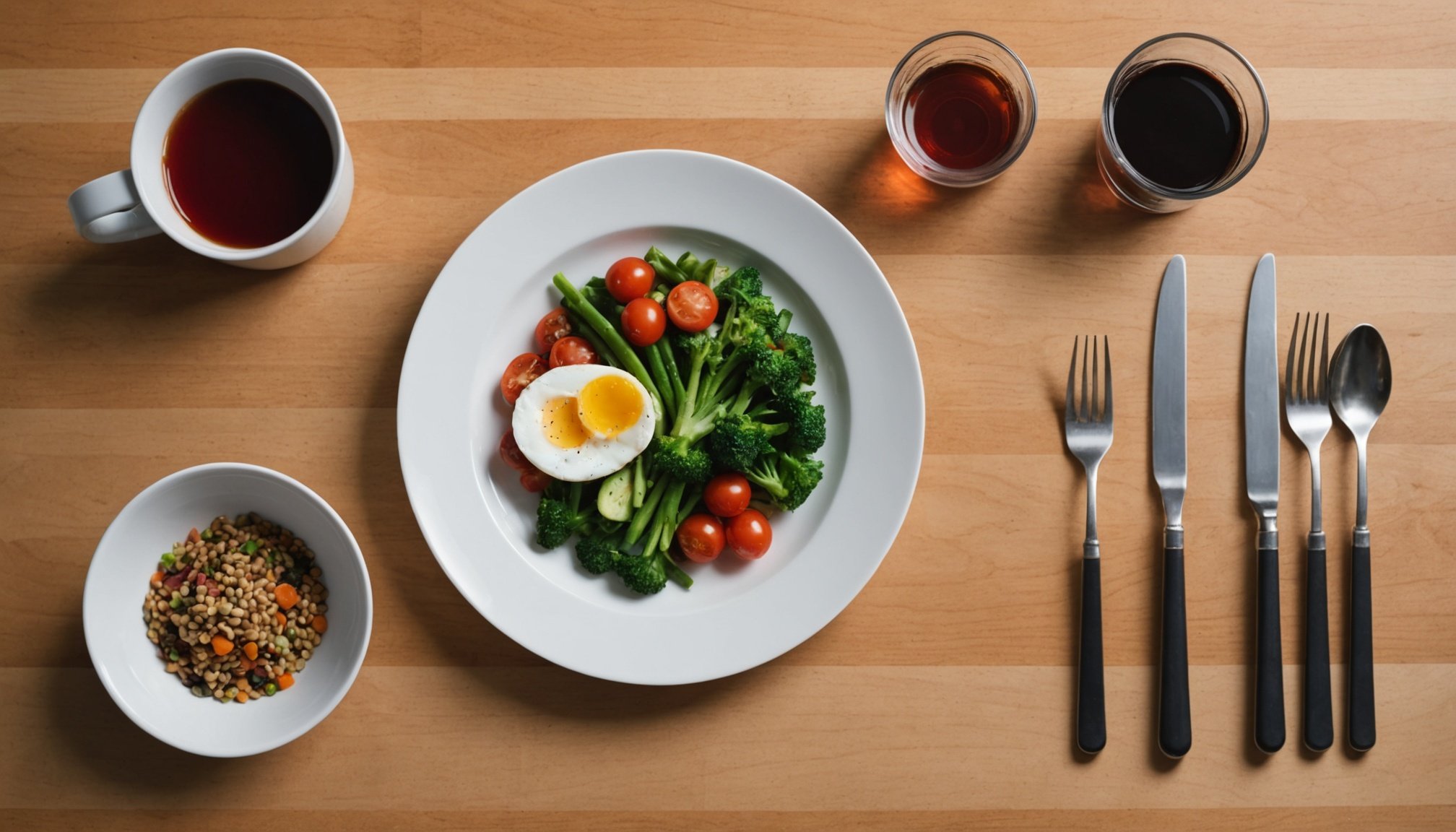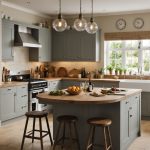Unlocking the Secrets of Minimalist Kitchen Art: How It Shapes Food Portion Control in Innovative Ways
In the realm of modern kitchen design, the minimalist approach has emerged as a beacon of simplicity, functionality, and aesthetic appeal. A minimalist kitchen is not just about stripping away clutter; it’s a thoughtful design philosophy that enhances the cooking experience and, importantly, influences how we control food portions. Let’s delve into the world of minimalist kitchens and explore how they shape food portion control in innovative and practical ways.
The Core Principles of Minimalist Kitchen Design
Minimalist kitchen design is built around several key principles that ensure the space is both beautiful and highly functional. Here are the core elements that define a minimalist kitchen:
Also to read : Discover the Impact: How Kitchen Cabinet Colors Shape Your Mood and Eating Patterns
Functionality and Simplicity
A minimalist kitchen prioritizes functionality and simplicity. Every item in the kitchen must serve a purpose, and the design should be easy to understand and use. This approach ensures that the kitchen remains clutter-free and focused on the essentials of cooking and meal preparation[1].
Clean Lines and Open Space
Clean lines, flat-panel doors, and frameless cabinets are hallmark features of minimalist kitchens. These design elements create a sleek, uncluttered look that enhances the sense of space and makes the kitchen feel more spacious. The use of open space is as crucial as the items within it, allowing for easy movement and a tranquil atmosphere[1].
Also to see : Discover the Top Digital Nutrition Scale for Perfect Macronutrient Tracking in Your Diet-Friendly Kitchen!
Selective Storage and Functional Zones
Effective storage is critical in a minimalist kitchen. Drawers and cupboards with simple hardware are used to store utensils and appliances, keeping countertops clear. The kitchen is divided into functional zones for food preparation, cooking, and cleaning, which streamlines movement and maintains an uncluttered environment[1].
How Minimalist Kitchens Influence Food Portion Control
A minimalist kitchen, by its very nature, encourages a more mindful approach to cooking and food portion control. Here are some ways in which a minimalist kitchen design can shape your approach to food portions:
Focus on Essential Items
In a minimalist kitchen, only essential items are kept on display or within easy reach. This selective approach to kitchen tools and dishes helps in avoiding over-preparation and encourages the use of only what is necessary for the meal at hand. For example, having a limited set of plates and bowls can help in portioning food more accurately, as you are less likely to serve oversized portions just because you have larger dishes available[2].
Streamlined Meal Preparation
The functional zones in a minimalist kitchen ensure that meal preparation is streamlined and efficient. With designated areas for each stage of cooking, you are more likely to measure ingredients accurately and prepare dishes in a controlled manner. This structured approach to cooking reduces the likelihood of over-preparing food, thereby helping in better portion control.
Use of Appropriate Dishes and Utensils
Minimalist kitchens often feature a limited but high-quality set of dishes and utensils. Using smaller, well-designed cutting boards, pots, and pans can help in preparing and serving the right portions. For instance, a smaller cutting board might encourage you to chop vegetables in manageable quantities, while a smaller pot might prevent you from cooking too much food at once.
Practical Tips for Implementing Minimalist Kitchen Design
If you’re considering transforming your kitchen into a minimalist haven, here are some practical tips to get you started:
Declutter Your Kitchen
Start by removing all unnecessary items from your kitchen. Sort through small appliances, extra mugs, and decorative items. If you don’t use them regularly, consider getting rid of them or storing them away. This initial decluttering process sets the stage for a more streamlined and functional kitchen[2].
Opt for Handless Kitchen Cabinets
Handless kitchen cabinets can add a sleek, modern touch to your kitchen while maintaining simplicity. These cabinets use sliding doors or touch-to-open mechanisms, which keep the look neat and streamlined. This design choice also encourages you to keep only what is necessary inside the cabinets, further aiding in portion control[2].
Choose the Right Materials and Colors
Select high-quality, durable materials for your kitchen design. Natural materials like wood, stone, and marble can bring warmth and elegance to the space. A neutral color palette, such as white, gray, or beige, can make the kitchen look more spacious and calm. These choices not only enhance the aesthetic but also create a serene environment that promotes mindful cooking and portion control[1][2].
Innovative Storage Solutions for Better Portion Control
Effective storage is a cornerstone of minimalist kitchen design, and it plays a significant role in food portion control. Here are some innovative storage solutions that can help:
Vertical Storage
Using vertical lines and simple geometric forms in cabinet design can maximize storage space. High-gloss laminates and natural woods are popular choices for their ability to create a streamlined look. Vertical storage solutions like wall-mounted shelves and tall cabinets keep essential items within easy reach while maintaining a clutter-free countertop[1].
Integrated Appliances
Integrated appliances that align flush with the cabinetry create a sleek, uniform look. Refrigerators installed within cabinetry, dishwashers concealed behind cabinet fronts, and ovens positioned at eye level all contribute to a streamlined kitchen. These integrated appliances do not disrupt the minimalist aesthetic but enhance it, making it easier to manage food portions during meal preparation[1].
Functional Kitchen Islands
Kitchen islands and peninsulas are central features in many minimalist designs, serving multiple functions from prep space to dining area. These islands can include storage solutions and integrated appliances, keeping the main kitchen area uncluttered. For example, a kitchen island with a prep sink and under-counter cabinets can help in preparing meals in a controlled environment, aiding in accurate portioning[1].
The Role of Lighting and Color in Minimalist Kitchens
Lighting and color play crucial roles in creating a minimalist kitchen that promotes mindful cooking and portion control.
Lighting
Natural and artificial lighting can define the space in a minimalist kitchen. Proper lighting helps in creating a clear and uncluttered environment, making it easier to measure ingredients and portion food accurately. For instance, under-cabinet lighting can illuminate the countertops, reducing shadows and making it easier to see what you are preparing[1].
Color Scheme
A minimalist kitchen often features a monochromatic or neutral color scheme. This simplicity in color helps in creating a calm and focused environment. Neutral colors like white, gray, and beige reflect more light, making the kitchen look more spacious and airy. This visual clarity aids in maintaining a clean and organized workspace, which is essential for accurate food portioning[2].
Real-Life Examples and Anecdotes
To illustrate how a minimalist kitchen can shape food portion control, let’s look at a few real-life examples:
A Busy Professional’s Kitchen
Sarah, a busy professional, transformed her kitchen into a minimalist space to streamline her meal preparation. She opted for a limited set of high-quality dishes and utensils, which helped her in preparing meals quickly and accurately. With a kitchen island that included a prep sink and storage, Sarah found it easier to portion her food correctly, even on the most hectic days.
A Family’s Casual Dining Experience
The Smith family decided to adopt a minimalist kitchen design to enhance their casual dining experience. They chose natural materials like wood and stone for their cabinetry and countertops, which added warmth to the space. By using handless kitchen cabinets and integrated appliances, they maintained a clutter-free environment that encouraged mindful cooking and accurate portioning. This design change helped the family in enjoying healthier, more balanced meals together.
Table: Comparing Traditional and Minimalist Kitchen Designs
Here’s a comparative table highlighting the key differences between traditional and minimalist kitchen designs, particularly in terms of food portion control:
| Feature | Traditional Kitchen | Minimalist Kitchen |
|---|---|---|
| Storage | Cluttered with many items | Selective storage, clear countertops |
| Appliances | Visible and often bulky | Integrated, sleek designs |
| Color Scheme | Varied and colorful | Neutral, monochromatic |
| Utensils and Dishes | Many options, often oversized | Limited, high-quality set |
| Meal Preparation | Often chaotic and disorganized | Streamlined, functional zones |
| Portion Control | Difficult due to clutter | Easier with clear workspace and essential items only |
| Materials | Mixed, often less durable | High-quality, natural materials |
| Lighting | Inadequate or harsh | Balanced, natural and artificial |
A minimalist kitchen is more than just a design trend; it’s a thoughtful approach to creating a space that is both beautiful and functional. By focusing on simplicity, clean lines, and selective storage, a minimalist kitchen encourages a more mindful approach to cooking and food portion control. Whether you’re a busy professional or a family looking to enhance your dining experience, adopting a minimalist kitchen design can have a profound impact on how you prepare and enjoy your meals.
As Alan Coleman from Cyncly notes, “Designing a kitchen that is both functional and stylish requires careful planning.” A minimalist kitchen, with its emphasis on function and simplicity, is the perfect example of such careful planning. By integrating innovative storage solutions, using the right materials and colors, and optimizing the kitchen layout, you can create a space that not only looks stunning but also helps you in maintaining healthy food portions.
In the words of a homeowner who recently adopted a minimalist kitchen design, “The simplicity of our new kitchen has changed the way we cook and eat. It’s not just about the look; it’s about the experience and the health benefits that come with it.” This sentiment encapsulates the essence of a minimalist kitchen – a space where form and function blend seamlessly to enhance your real-life cooking and dining experiences.






